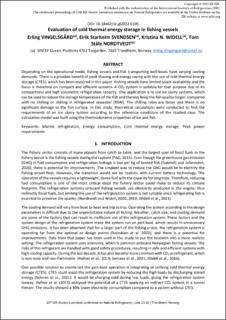| dc.contributor.author | Vingelsgård, Erling | |
| dc.contributor.author | Svendsen, Eirik Starheim | |
| dc.contributor.author | Widell, Kristina Norne | |
| dc.date.accessioned | 2023-06-13T12:05:21Z | |
| dc.date.available | 2023-06-13T12:05:21Z | |
| dc.date.created | 2022-11-11T14:00:08Z | |
| dc.date.issued | 2022 | |
| dc.identifier.isbn | 978-2-36215-045-6 | |
| dc.identifier.issn | 0151-1637 | |
| dc.identifier.uri | https://hdl.handle.net/11250/3071150 | |
| dc.description.abstract | Depending on the operational mode, fishing vessels and fish transporting well-boats have varying cooling demands. There is a possible benefit of peak shaving and energy saving with the use of cold thermal energy storage (CTES), which has been explored in this paper. Fishing vessels have limited space availability and the focus is therefore on compact and efficient systems. A CO2 system is suitable for that purpose due to its compactness and high volumetric refrigeration capacity. One application is to use ice slurry systems, which can be used to reduce the storage temperature of the fish and thereby keep the fish quality longer, compared with no chilling or chilling in refrigerated seawater (RSW). The chilling rates are faster and there is no significant damage to the fish surface. In this study, theoretical calculations were conducted to find the requirements of an ice slurry system according to the reference conditions of the studied case. The calculation model was built using the thermodynamic properties of ice and fish. | en_US |
| dc.language.iso | eng | en_US |
| dc.publisher | International Institute of Refrigeration | en_US |
| dc.relation.ispartof | 15th IIR-Gustav Lorentzen Conference on Natural Refrigerants - GL2022 - Proceedings - Trondheim, Norway, June 13-15th 2022 | |
| dc.title | Evaluation of cold thermal energy storage in fishing vessels | en_US |
| dc.title.alternative | Evaluation of cold thermal energy storage in fishing vessels | en_US |
| dc.type | Chapter | en_US |
| dc.type | Peer reviewed | en_US |
| dc.description.version | acceptedVersion | en_US |
| dc.source.journal | Science et technique du froid | en_US |
| dc.identifier.doi | 10.18462/iir.gl2022.0105 | |
| dc.identifier.cristin | 2072531 | |
| dc.relation.project | Norges forskningsråd: 294662 | en_US |
| cristin.ispublished | true | |
| cristin.fulltext | original | |
| cristin.qualitycode | 1 | |
